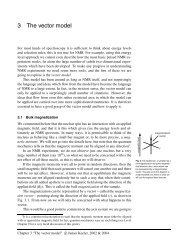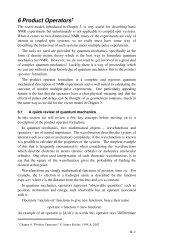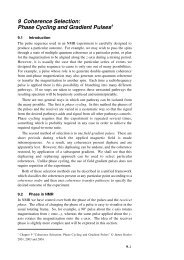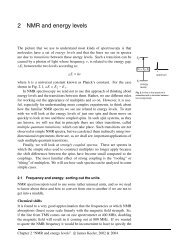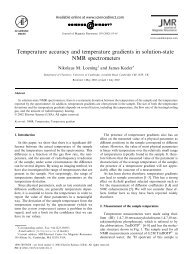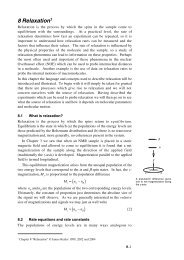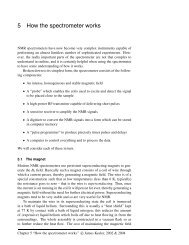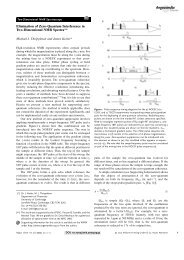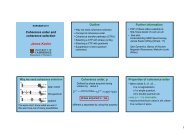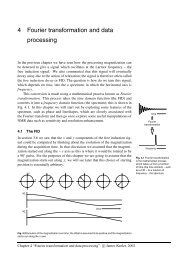Phase Cycling and Gradient Pulses - The James Keeler Group
Phase Cycling and Gradient Pulses - The James Keeler Group
Phase Cycling and Gradient Pulses - The James Keeler Group
Create successful ePaper yourself
Turn your PDF publications into a flip-book with our unique Google optimized e-Paper software.
dimensional spectra. This is considered in more detail in section 9.5.6.<br />
9.5.5.2 <strong>Group</strong>ing pulses together<br />
<strong>The</strong> sequence shown opposite can be used to generate multiple quantum<br />
coherence from equilibrium magnetization; during the spin echo anti-phase<br />
magnetization develops <strong>and</strong> the final pulse transfers this into multiple quantum<br />
coherence. Let us suppose that we wish to generate double quantum, with p =<br />
±2, as show by the CTP opposite.<br />
As has already been noted, the first pulse can only generate p = ±1 <strong>and</strong> the<br />
180° pulse only causes a change in the sign of the coherence order. <strong>The</strong> only<br />
pulse we need to be concerned with is the final one which we want to generate<br />
only double quantum. We could try to devise a phase cycle for the last pulse<br />
alone or we could simply group all three pulses together <strong>and</strong> imagine that, as a<br />
group, they achieve the transformation p = 0 to p = ±2 i.e. ∆p = ±2. <strong>The</strong> phase<br />
cycle would simply be for the three pulses together to go 0°, 90°, 180°, 270°,<br />
with the receiver going 0°, 180°, 0°, 180°.<br />
It has to be recognised that by cycling a group of pulses together we are only<br />
selecting an overall transformation; the coherence orders present within the<br />
group of pulses are not being selected. It is up to the designer of the experiment<br />
to decide whether or not this degree of selection is sufficient.<br />
<strong>The</strong> four step cycle mentioned above also selects ∆p = ±6; again, we would<br />
have to decide whether or not such high orders of coherence were likely to be<br />
present in the spin system. Finally, we note that the ∆p values for the final<br />
pulse are ±1, ±3; it would not be possible to devise a four step cycle which<br />
selects all of these pathways.<br />
2<br />
1<br />
0<br />
–1<br />
–2<br />
Pulse sequence for generating<br />
double-quantum coherence.<br />
Note that the 180° pulse simply<br />
causes a change in the sign of<br />
the coherence order.<br />
9.5.5.3 <strong>The</strong> last pulse<br />
We noted above that only coherence order –1 is observable. So, although the<br />
final pulse of a sequence may cause transfer to many different orders of<br />
coherence, only transfers to p = –1 will result in observable signals. Thus, if<br />
we have already selected, in an unambiguous way, a particular set of coherence<br />
orders present just before the last pulse, no further cycling of this pulse is<br />
needed.<br />
9.5.5.4 Example – DQF COSY<br />
A good example of the applications of these ideas is in devising a phase cycle<br />
for DQF COSY, whose pulse sequence <strong>and</strong> CTP is shown below.<br />
t 1 t 2<br />
p<br />
2<br />
1<br />
0<br />
–1<br />
–2<br />
∆p=±1 ±1,±3<br />
+1,–3<br />
Note that we have retained symmetrical pathways in t 1<br />
so that absorption mode<br />
9–27



